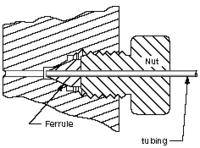
The Investigation of Dynamic Changes of the Particle Surface Charge with Resistive-Pulse Technique
Sign Up to like & getrecommendations! Published in 2017 at "Biophysical Journal"
DOI: 10.1016/j.bpj.2016.11.1793
Abstract: In the resistive-pulse technique, individual particles passing through a pore cause transient changes of the transmembrane current, and the amplitude of the current change corresponds to the object size. This method has been applied to… read more here.
Keywords: surface charge; particle surface; surface; pulse technique ... See more keywords

Silver Nanoneedle Probes Enable Sustained DC Current, Single-Channel Resistive Pulse Nanopore Sensing.
Sign Up to like & getrecommendations! Published in 2021 at "Analytical chemistry"
DOI: 10.1021/acs.analchem.1c02087
Abstract: Resistive pulse sensing using ion channel proteins (biological nanopores) has been evolving as a single-molecule approach to detect small biomolecules owing to atomically precise pore size reproducibility, high signal-to-noise ratio, and molecular selectivity. The incorporation… read more here.
Keywords: resistive pulse; channel; ion channel; silver nanoneedle ... See more keywords

Electrochemical Resistive-Pulse Sensing of Extracellular Vesicles.
Sign Up to like & getrecommendations! Published in 2022 at "Analytical chemistry"
DOI: 10.1021/acs.analchem.2c01216
Abstract: Extracellular vesicles (EVs) released from biological cells have attracted considerable interest due to their potential for cancer diagnostics and important role in cell signaling. Most previously reported studies have been concerned with the detection of… read more here.
Keywords: cell; extracellular vesicles; electrochemical resistive; erp sensing ... See more keywords

Tunable Resistive Pulse Sensing: Better Size and Charge Measurements for Submicrometer Colloids.
Sign Up to like & getrecommendations! Published in 2018 at "Analytical chemistry"
DOI: 10.1021/acs.analchem.7b05106
Abstract: Tunable resistive pulse sensing (TRPS) uses the Coulter principle to detect, measure, and analyze particles at length scales ranging from tens of nanometers through to micrometers. The technology and its associated methods have advanced so… read more here.
Keywords: resistive pulse; tunable resistive; pulse sensing; size charge ... See more keywords

Resistive-Pulse Sensing and Surface Charge Analysis of a Single Nanoparticle Collision at a Conical Glass Nanopore.
Sign Up to like & getrecommendations! Published in 2019 at "Analytical chemistry"
DOI: 10.1021/acs.analchem.9b00553
Abstract: In this study, the collision of monodispersed single Au@SiO2 nanoparticles (NPs; ∼83.5 ± 6.5 nm) at the outer orifice of a smaller-sized (∼40 ± 8 nm) conical glass nanopore was systematically investigated by the resistive-pulse… read more here.
Keywords: resistive pulse; collision; conical glass; surface charge ... See more keywords

In-Plane, In-Series Nanopores with Circular Cross Sections for Resistive-Pulse Sensing.
Sign Up to like & getrecommendations! Published in 2022 at "ACS nano"
DOI: 10.1021/acsnano.1c08680
Abstract: Resistive-pulse sensing with solid-state nanopores is a sensitive, label-free technique for analyzing single molecules in solution. To add functionality to resistive-pulse measurements, direct coupling of the nanopores to other pores and nanoscale fluidic elements, e.g.,… read more here.
Keywords: plane; cross sections; circular cross; resistive pulse ... See more keywords

A Tunable 3D Printed Microfluidic Resistive Pulse Sensor for the Characterisation of Algae and Microplastics.
Sign Up to like & getrecommendations! Published in 2020 at "ACS sensors"
DOI: 10.1021/acssensors.0c00987
Abstract: Technologies that can detect and characterise particulates in liquids have applications in health, food and environmental monitoring. Simply counting the numbers of cells or particles, is not sufficient for most applications; other physical properties must… read more here.
Keywords: pulse; printed microfluidic; resistive pulse; sensor ... See more keywords

Ligand-Induced Structural Changes of Thiolate-Capped Gold Nanoclusters Observed with Resistive-Pulse Nanopore Sensing.
Sign Up to like & getrecommendations! Published in 2019 at "Journal of the American Chemical Society"
DOI: 10.1021/jacs.8b12535
Abstract: Nanopore-based resistive pulse sensing with biological nanopores has traditionally been applied to biopolymer analysis, but more recently, interest has grown in applying the technique to characterizing water-soluble metallic clusters. This paper reports on the use… read more here.
Keywords: capped gold; nanopore sensing; gold nanoclusters; thiolate capped ... See more keywords

Resistive-Pulse Sensing Inside Single Living Cells.
Sign Up to like & getrecommendations! Published in 2020 at "Journal of the American Chemical Society"
DOI: 10.1021/jacs.9b13796
Abstract: Resistive-pulse sensing is a technique widely used to detect single nanoscopic entities such as nanoparticles and large molecules that can block the ion current flow through a nanopore or a nanopipette. Although the species of… read more here.
Keywords: resistive pulse; pulse sensing; sensing inside; living cells ... See more keywords